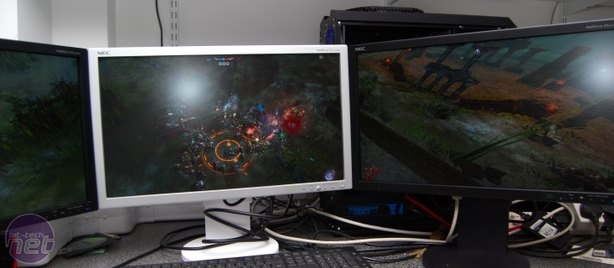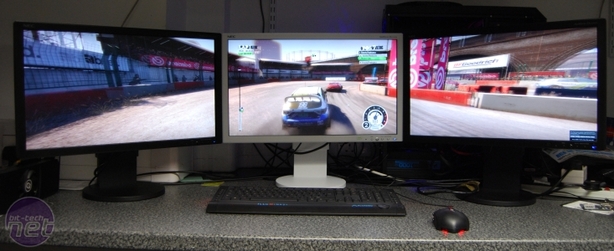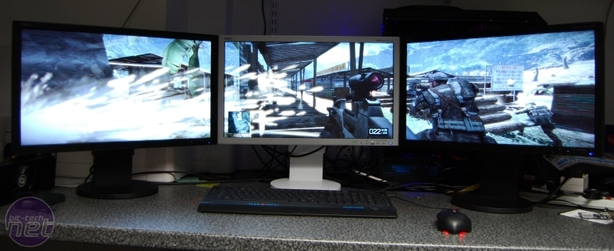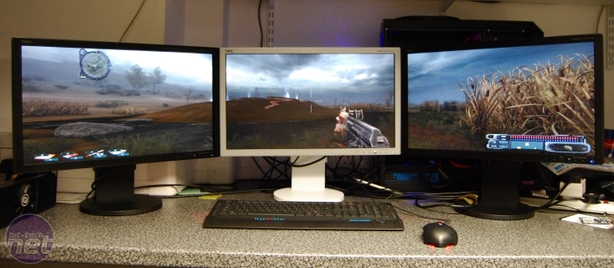
What’s it like to use Eyefinity?
As we’ve previously said in our hands-on preview of Eyefinity, the technology behind Eyefinity works by grouping multiple displays into one Single Large Screen (SLS) for the graphics card to work on - and as a result, it requires all the screens in the group to be the same resolution, orientation and colour depth.This means Eyefinity can’t support the old flight-sim trick of having one 24in screen inbetween two 20in screens in portrait; the upshot of Eyefinity's enforced conformity is that if you’re using three widescreen displays, the viewable area of the game becomes incredibly wide and really fills your peripheral vision.
With three screens, it’s natural to bend the left and right displays to make a concave arrangement of TFTs. This works well with games that use a first- or third-person view, as the viewport (i.e., the portion of the game that gets drawn and displayed) has an element of wrap-around at very wide aspect ratios. You can see cars coming up alongside you when driving, or comrades running up to support your flank with some covering fire.

The wrap-around screens made things look a little odd in Chaos Rising - Piza would be happy to have those buildings on the right screen
However, this arrangement is less than ideal when you switch to an isometric viewpoint. Such viewpoints want to treat the viewed area as being flat, so by bending the displays in you get weird distortions – buildings with walls at 45 degree angles and so on. When we were playing Dawn of War II we moved the left and screen to be flat with the central and saw this effect disappear. However, we now had a display that was several foot long, which meant we had to crane our neck or even move our chair to see details at the extreme left or right of the screen.
Overall though, our experience of Eyefinity was positive - size does matter, and games across three screens look good. While there are a few niggles with certain games – the main menu of Bad Company 2 didn’t stretch properly, meaning that the cursor wasn’t aligned with the menu and we had trouble applying the 5,760 x 1,080 resolution – we missed the second and third screen when we removed them.

Grid looked pretty good on Eyefinity, if we struggled to find much usefulness in neing able to see more of the wall we were driving alongside
That’s a fair indication that a technology is at least partially successful, and is a much better reaction than we’ve had with 3D Vision, where for most people, it’s frankly a relief to finally take off the bulky 3D Vision glasses. Going from Eyefinity to just a single screen feels like going from a widescreen monitor to a 5:4 one did, back when widescreen gaming was starting to take off.
However, this enthusiasm is tempered by the fact that Eyefinity is a bit of a pain to set up and live with. Beyond the obvious cost issues, there’s the amount of desk space that the screens use up, and the feeling that three widescreen monitors sat side-by-side is too wide. We found that our peripheral vision really only extended about halfway across the side-screens, and that the screens looked too skinny vertically (possibly a consequence of their 16:9 aspect ratio).
While the two pillars of double-thick bezels to either side of the central screen didn’t bother us too much, we’re left hoping that someone follows Philips’ lead with 21:9 aspect TVs, and makes a super-widescreen monitor. We’ve seen Alienware demo something like this, but that project has since been abandoned.

MSI MPG Velox 100R Chassis Review
October 14 2021 | 15:04










Want to comment? Please log in.